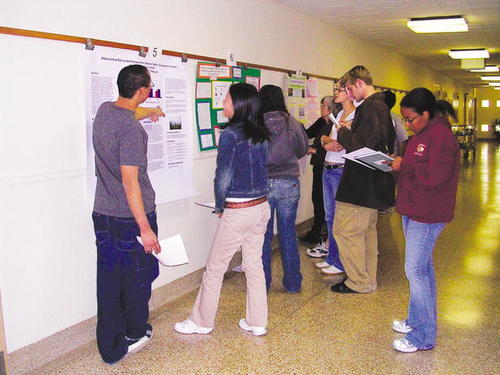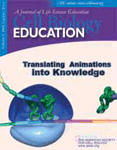Points of View: A Survey of Survey Courses: Are They Effective?
OUR MOTIVATION
In spring of 1998, the Biology Department at Pomona College changed from a two-semester survey introductory biology sequence to a core set of three courses, none of which is a traditional survey course. We had been wrestling for several years with a number of issues regarding the survey courses, including 1) what topics to include and exclude, 2) the perception by our students that these survey courses were “like high school biology,” 3) the anonymity felt by students in the large (for us: 90-120 students) lectures, and 4) the impersonality of giving those lectures. We finally made a breakthrough when we went through the exercise of starting from scratch to design an introductory curriculum that 1) we would enjoy teaching, 2) would introduce our students to the fundamental principles and methods of practicing biology, and 3) would excite our students about biology in general.
THE COURSES
We decided that the first course would be centered on the thread that runs through all types of biology: genetics (see Table 1). Genetics is offered in the spring semester so students can take the first semester of general chemistry in the fall semester. The Introductory Genetics course (current text is Genetics, Hartwell et al., or Principles of Genetics, Snustad and Simmons, depending on section) starts with transmission genetics, moves to the central dogma and molecular genetics, then finishes with population genetics. This introduction to biology via genetics sets the stage for the remaining two core courses: Cell Chemistry & Cell Biology and Ecology & Evolution. Introductory Cell Chemistry & Cell Biology covers basic biochemistry, membranes, membrane transport, action potentials, intermediary metabolism, and a number of additional aspects of cell biology. Introductory Ecological & Evolutionary Biology includes evolutionary and population biology, behavioral and community ecology, and conservation biology. Both Cell Chemistry & Cell Biology and Ecology & Evolution are taught as sophomore-level courses (text for Cell Chemistry & Cell Biology is World of the Cell, Becker [no relation], Kleinsmith, Hardin, and the texts used for Ecology & Evolution are Essentials of Ecology, Townsend, Begon, and Harper, plus Evolutionary Analysis, Freeman and Herron). Students are introduced to primary literature in both courses. The laboratory components of cell Chemistry & Cell Biology and Ecology & Evolution emphasize the processes of biology: hypothesis formulation, experimental design, performing experiments, analysis of data, and communication of results. In each course, students design projects, conduct experiments, and report (orally, in journal-article format, and/or by poster; Figure 1) their findings. Upper-level courses are available as a smorgasbord, each having either Cell Chemistry & Cell Biology or Ecology& Evolution as a prerequisite. Thus, students may start taking upper-level courses as early as the spring of their sophomore year.
Course Formats
For all three introductory courses, we opted for depth at the expense of breadth. The primary objective was to get beyond the descriptive aspects to more interesting and even unresolved issues. For Cell Chemistry & Cell Biology, for example, this meant talking about mechanisms and strategies for regulation of pathways and processes, while illustrating how models have changed over time and giving multiple examples when there are competing models. To the extent that we can, we describe seminal experiments to include not only what we know about a topic, but also how we know it. The goal is to get students to think critically about what they are learning, gain an appreciation for the practice of biology, and find the process exciting enough to continue in biology. In addition, this format is much more interesting for us to teach. We want our students to understand that we are not biologists because we like to memorize information, but rather because we like to use the information to ask and answer questions about biology.
All three courses were developed by the three subsets of the biology faculty that teach them, and all three course designs were presented to and vetted by the department as a whole. Even with different faculty teaching the different sections, we felt it was desirable for content to be consistent. For each course there is an “equalizer” that describes in some detail the topics covered. Thus, those teaching Cell Chemistry & Cell Biology and Ecology & Evolution know exactly the extent of genetics background their students have when they enter each course. Likewise, for upper-level courses, we know quite specifically to what topics the students have been exposed and to what levels. Additionally we know they have begun to read the primary literature, so we can opt to make heavy use of it at the outset in upper-level courses.
Organismal Biology. I can hear the organismal biologists moaning (or worse) as they read about our core course contents. This is an issue that we discussed at length during the formulation of our introductory curriculum, and the decision to omit organismal biology per se from the core courses came with the following two conditions: 1) we would consciously choose a variety of organisms for use in the labs for the three courses and would spend appropriate time describing each organism, placing it in a larger context; and 2) our majors are required to select at least one upper-level course (with lab) that qualifies as organismal (addresses topics at the level of the organism for a majority of the course). Examples of organismal courses include Animal Physiology, Plant Physiology, Animal Behavior, and Comparative Endocrinology. Personally, I don't feel that we have been successful in these attempts to include biology studied at the organismal level. I expect that next year we will take up the organismal biology issue again. Some biology departments have four courses in their introductory/core sequences, and that is one of the possible solutions we will discuss. To keep the small sections in the introductory courses will be a challenge, however, if we add a fourth course. Maintaining small class sizes was one of the issues that led us originally to the sequence of three courses, and it remains to be seen if we would be able to staff a fourth core course.
Small Multiple Sections. Just as significant as the course content change, we also adopted the multiple-small-section model, à la calculus. A full-time faculty member teaches each section, including the weekly lab section. We currently teach four sections of Introductory Genetics each spring, three sections of Introductory Cell Chemistry & Cell Biology, and two sections of Introductory Ecological & Evolutionary Biology. Section sizes are typically 24-32 students, which permits the classes to be much more interactive. Because the faculty member teaches both class and lab, he or she gets to know the students quite well and vice versa. Small classes also permit more overt connections between classroom topics and lab activities. Students and faculty alike are much happier with the small sections, but a consequence of the increased staffing requirements is that fewer upper-level courses are offered.
Figure 1. Poster session in Cell Biology & Cell Chemistry. Student pairs design and carry out projects on photosynthesis in which they ultimately measure and express rates of photosynthesis as light-dependent oxygen evolution. Projects this year included ultraviolet B effects; comparisons among C-3 plants, C-4 plants, and Crassulacean acid metabolism plants; circadian rhythm effects; elevated CO2 levels; and foliar iron application. Students present their work to each other in a poster session, in which peer evaluation is an important aspect. Their previous project (on succinate dehydrogenase) was presented via oral presentations and in papers written in journal-article style.
DID WE SUCCEED?
Beginning with a genetics course addressed the issue of our students' first biology course not appearing to be a repeat of a high school class. Nearly all of our students have taken biology in high school, and significantly more than half have taken advanced placement (AP) biology. We did a study and an experiment prior to 1998 to address the question of whether or not we should place students who scored a 4 or 5 on the AP biology exam out of the first course in our survey sequence. The study compared AP scores of students who took the first survey course with the grades they earned in the course. There was no correlation between AP score and college survey grade and, furthermore, students who had not taken AP biology in high school fell in the same distribution of grades as the students who had. We had no way to test our hypothesis directly, but we felt that the familiarity of topics in the survey course gave the students a false sense of competence, and our level of expectation for their performance exceeded theirs. This disconnect between performance and expectations resulted in a less-than-satisfactory situation. The experiment we performed was to offer students who had scored 5 on the AP exam the choice to skip the first course and enter the second one directly. Skipping the first course overwhelmed the handful of students who selected that option. They all performed quite poorly in the second course, probably due to a variety of factors. They had not experienced the adjustment to college biology courses (especially the labs and the exams), they were first-year students in a class of sophomores and juniors, they had not been through a semester of general chemistry, and they were making the general adjustments to college life in their first semester on campus. Not surprisingly, we do not place any students out of Introductory Genetics in the new curriculum.
The smaller class sizes successfully addressed the other issues listed above. Faculty and students engage with the material together in the classes, with discussions in addition to lectures. Even the lectures can follow a more Socratic method. Anonymity and impersonality have disappeared from our introductory courses.
QUESTIONS OF CURRICULAR FIT
Nonmajors take the genetics course if they wish to take a biology course. Consequently, a number of examples used and topics discussed are of practical value and popular interest. For example, human genetic diseases are used frequently as examples, eugenics is discussed, and both genetic counseling and agricultural breeding applications are included in the quantitative genetics and population genetics content. If a student is going to take a single biology course in college, we feel genetics is the appropriate one, and typically one-half of the students in the Introductory Genetics class do not major in the three possible life science majors: biology, neuroscience, or molecular biology.
One difficulty that arises as a consequence of our new introductory curriculum is placing transfer students into the appropriate course. Typically, there is some redundancy with introductory courses they have taken elsewhere, but there is enough difference that in most cases the transfer students are best served by taking all three of our introductory courses. We have to consider transfer students on a case-by-case basis, and fortunately we do not have large numbers, so this does not present a major challenge. At an institution with larger numbers of transfer students, this would be a much larger problem.
THE BOTTOM LINE
Overall, we are pleased with our nonsurvey introductory sequence of courses, and we believe they meet our objectives better than their predecessors—a two-semester sequence of survey courses. We are not satisfied, however, with the current means to include organismal biology in our curriculum, and we will address this shortcoming again in the near future. It is impossible to determine the relative contributions by the structure of the courses versus the small class sizes to the apparent success (student satisfaction, faculty satisfaction, student success in post-Pomona biology-related endeavors) of the curriculum. Undoubtedly, both are important. What we particularly like are the increased level of student engagement with the material in the courses, the opportunity to emphasize the processes of“ doing biology” in both class and lab, the increased depth of coverage of the topics in the courses, and the closer relationship that develops between teachers and students.



